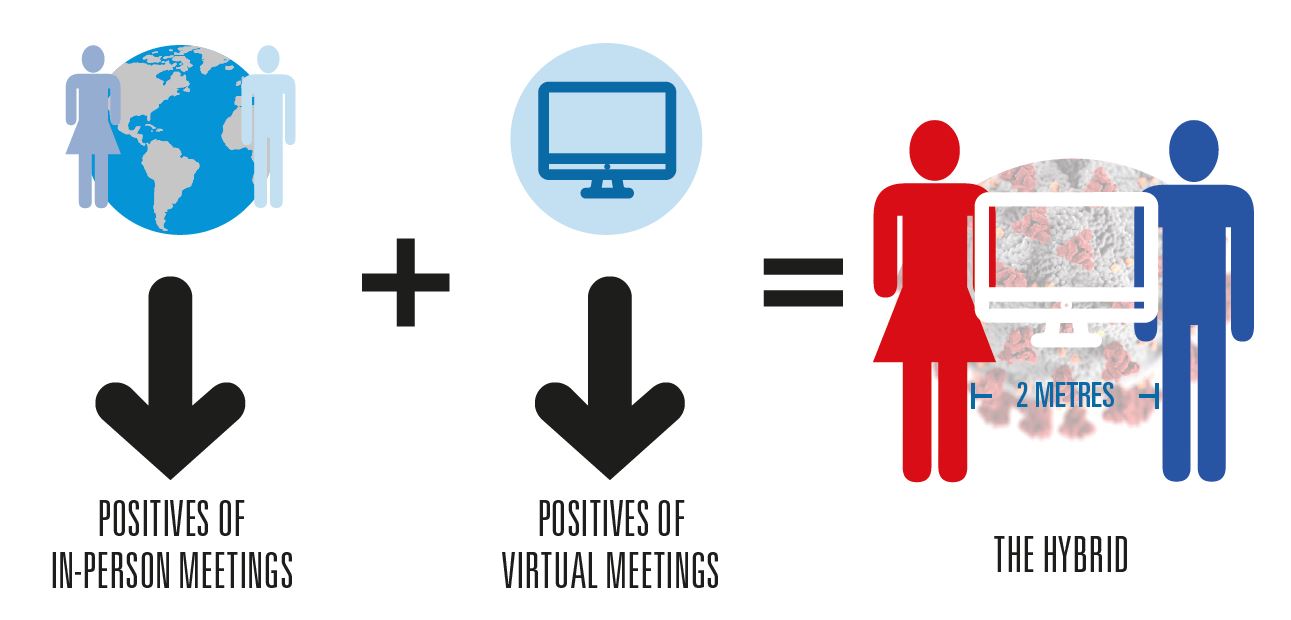 “2020 has changed so much. But the need for IO education remains the same.” Cued to music and set against a backdrop of footage from previous conferences, lone individuals on laptops, and graphics of the now instantly-recognisable SARS-CoV-19 virus, this is the text that appears on the promotional video for the Symposium on Clinical Interventional Oncology (CIO), which took place virtually for the first time ever this year, with sessions livestreamed on each Tuesday in October 2020. “Undeterred by setbacks,” it continues, “this is your year to learn differently. Meet differently. See IO… differently.” At the time of writing, CIO 2020 is the most recent conference in the interventional radiology (IR) space to deliver education and networking opportunities online. As interventional radiologists look ahead to 2021, Interventional News speaks with thought leaders from IR societies across the world to capture their reflections on how the COVID-19 pandemic is impacting medical education.
“2020 has changed so much. But the need for IO education remains the same.” Cued to music and set against a backdrop of footage from previous conferences, lone individuals on laptops, and graphics of the now instantly-recognisable SARS-CoV-19 virus, this is the text that appears on the promotional video for the Symposium on Clinical Interventional Oncology (CIO), which took place virtually for the first time ever this year, with sessions livestreamed on each Tuesday in October 2020. “Undeterred by setbacks,” it continues, “this is your year to learn differently. Meet differently. See IO… differently.” At the time of writing, CIO 2020 is the most recent conference in the interventional radiology (IR) space to deliver education and networking opportunities online. As interventional radiologists look ahead to 2021, Interventional News speaks with thought leaders from IR societies across the world to capture their reflections on how the COVID-19 pandemic is impacting medical education.
“I do not think the pandemic is the end of the in-person meeting, rather the beginning of offering meetings accessible to all,” Erica Holland, interim executive director of the Society of Interventional Radiology (SIR), says. “SIR’s meetings, especially the annual scientific meeting, always feel like a family reunion, and we are looking forward to reuniting with our IR family as soon as it is safe to do so.”
Originally slated to be an in-person meeting in Seattle, USA, on 28 March–2 April 2020, the SIR annual scientific meeting was amongst the first events to be cancelled due to the COVID-19 pandemic. Constantino Peña (Miami Cardiac & Vascular Institute, Miami, USA), SIR 2020 programme chair, tells this newspaper this was “a disappointment”: “The annual meeting committee had spent so many months planning the programme, the awards ceremonies, and the networking events, and was excited to share them with our peers. We knew many of the researchers were eager to share their science with their colleagues and hear the feedback that is so important to expanding their work.
“But we were confident at the time that we made the right decision and that has been proven by how the spring unfolded. As a medical society, we knew we needed to lead by example during this public health emergency and ensure we were protecting our patients, colleagues, families, and communities by not creating a potential to spread the virus further. Interventional radiologists are data-driven, and the data we were presented at the time was unmistakable. There was community spread in the Seattle area, then the epicentre of America’s outbreak. There was a call from local officials, the Centers for Disease Control and Prevention [CDC] and the World Health Organisation [WHO] to limit social interactions and avoid large groups to stop the spread. There was the information from our members telling us their institutions were limiting travel to flatten the curve and ready to respond to the inevitable outbreaks in their hometowns. The team came together, and absorbed and analysed data quickly to make a correct and timely decision.”
The emergence of a post-pandemic hybrid model

The annual meeting of the Chinese College of Interventionalists (CCI), initially scheduled for April 2020, was postponed due to the pandemic. Whilst SIR 2020 took place as a fully virtual event 13–14 June, CCI 2020 was rescheduled for 27–30 August as a hybrid virtual/ in-person meeting in Nanjing, China.
“Although this new meeting mode brings a unique attendee experience for CCI meetings, it also presents a big challenge in terms of planning, in order to ensure audience satisfaction,” Gao-Jun Teng, CCI president, says, thinking back to the months of preparation that went into the 2020 event. Seven host venues were used in total; a “main” venue in Nanjing, and six “branch venues” across the country, which CCI say “were to let more IR professionals easily get involved”. In total, there were over 16,000 registered participants, who were able to access 153 scientific and workshop sessions, 796 lectures, and 76 live demonstrations of IR procedures.
“I am proud to conclude CCI 2020 a big success,” Teng told virtual and in-person attendees of the meeting’s closing ceremony, “and [declare] it a ‘sweet marriage’ between the virtual and physical meeting settings. Except for the completely online English- speaking sessions, almost all lectures were delivered in physical meeting rooms in Nanjing and the other six cities, while most audiences could just stay at home. This has no doubt brought attendees great convenience to participate with minimum travel and cost. Most importantly, it also broke territorial boundaries to allow more attendees to engage in and more citizens to appreciate this fairly new but strongly developing, medical specialty.” Indeed, following the strength of the hybrid model’s success at CCI 2020, the college is continuing with this format in 2021.
These boons of increased attendance and accessibility facilitated by the virtual meeting have been echoed by other IR societies. President of the Cardiovascular and Interventional Radiological Society of Europe (CIRSE), Afshin Gangi (University Hospital of Strasbourg, Strasbourg, France) weighs in: “While I do believe that the virtual model brought a lot to the table in terms of accessibility, I strongly believe that the major congresses will go back to an in-person format after the pandemic. This, however, will not mean in-person only. We at CIRSE plan to also further develop a strong virtual component of our physical congresses; a hybrid model if you will. Medical education in general will of course require both in-person courses and congresses, as well as online learning opportunities. I believe for IR in particular, it is vital for professionals to be able to physically come together to meet, discuss important data, and interact with the latest technology. Virtual-only will not be the future.”
Speaking on behalf of SIR, Holland muses: “One of the interesting benefits of being all virtual is the fact that it has allowed us to expand access to our offerings to our members. We often hear that attendance at the annual scientific meeting is staggered in practices to ensure coverage at the home institutions, meaning some interventional radiologists attending may not be able to stay for the whole meeting, if they are able to attend at all. That is not generally an issue for virtual meetings as you can log on when you are available and absorb the discussion and even watch it on demand later on, depending on the meeting.
“Post-pandemic, I think you will see a pent-up demand for meeting again in person. Networking and community are a huge part of SIR’s meetings and part of the value of an in-person meeting are the sidebar conversations that happen after a presentation or when you bump into colleagues on your way to plenary session or expo hall. Those are impossible to replicate in the virtual space.
“At the same time, not everyone will be ready or able to attend our events in person, so we may see a hybrid model emerge that live streams what is happening on site for those who cannot be there in person.
“In addition, some of the virtual networking opportunities SIR created to fill the gaps while meeting sizes are still restricted, like our new virtual angio club series, are specifically designed to stay in the long term. Many of our members work in areas that do not have local angio clubs where they can regularly meet with their peers, learn, and exchange ideas. While SIR’s virtual club was born out of the necessity presented by the pandemic, it uncovered an important, longstanding need in our community, and we are excited to have this series continue in the long term to support interventional radiologists in their practice no matter where they are.”
When asked if she believed the future of medical conferences would follow a virtual, live, or hybrid model, Jena Eberly Stack, executive director of Society of Interventional Oncology (SIO), commented: “This is the million-dollar question! While I do not have a crystal ball, I can say that there are wonderful, unexpected benefits of virtual learning experiences, and there are also cherished, deeply missed aspects of in-person learning experiences. I am sure we will see a mix of both once we are able to safely meet in person again, offering tailored opportunities based on the type of information and education being shared.”
Spring IR conferences confirm they will be online-only events
Unlike the annual scientific meetings originally scheduled in the springtime, CIRSE had several months to anticipate the possibility of hosting a virtual meeting, something Gangi says was “essential […] to ensure everything went smoothly online”. Commenting on the event, held 12–15 September 2020, he adds: “We received overwhelmingly positive feedback from our stakeholders regarding the high calibre of educational content, interactive learning, and networking opportunities, and first-rate organisation. While of course we missed the opportunity of physically meeting together as in previous years, the CIRSE 2020 Summit was able to ensure an equally high level of educational content with our top-notch faculty streaming in from around the world, giving over 1,000 presentations, and also provide ample networking opportunities through the interactive presentation formats and chat functions available at every level of the platform.”
In total, there were 18,000 active users on the CIRSE 2020 Summit platform, the society claim, with almost 5,000 attendees from 115 different countries logging in and creating more than 20,000 chat messages over the course of the four live event days. While Gangi says these figures paint a positive picture of intra-conference communication, he adds this caveat: “I think the quality of interaction and collective creativity that is achievable online is not the same as we usually have at a physical congress. I therefore strongly hope that we will be able to meet again in-person at the CIRSE annual congress in 2021 in Lisbon, Portugal.” At the time of writing, this meeting is scheduled for 25–29 September 2021.
When questioned on his event expectations for 2021, Gangi said: “We are in the same spot as everyone else at the moment: waiting for a vaccine and hoping the situation will improve. While we hope and plan for in-person meetings, we are prepared to host the meetings in any format we can, and that might be online or in a hybrid format. One thing is certain—all CIRSE events in 2021, including the European Congress on Interventional Oncology (ECIO), the European Conference on Embolotherapy (ET), and the CIRSE annual scientific meeting will take place.”
Gearing up for SIO 2021, which will be held virtually 5–8 February 2021, Stack reflect on the 12 months’ experience the society has had to prepare for a potential online meeting (the society’s annual scientific meeting was one of the few IR congresses able to take place in person this year, 31 January–3 February 2020, New Orleans, USA). “The world certainly looks different today than it did a year ago, and our preparations for SIO 2021 reflect this shift in our landscape,” she says.
“We have held and observed several virtual events over the last seven months, and the learnings from those activities have provided feedback we are incorporating into our planning process for SIO 2021. Providing timely programming, valuable avenues to skill-build, and quality networking opportunities remain our commitment to our attendees, and we are achieving this through thoughtful programme development. SIO 2021 will be an interactive experience—not just a series of webinars—designed to mimic the best parts of an in-person event and capitalise on the unique opportunities a virtual event has to offer.”
SIR 2021 will also be held online. Peña assures readers that this “will be a completely different experience from any previous SIR meeting, including the SIR 2020 virtual offering”. He elaborates: “Given the uncertainty of the landscape, the unique nature of our specialty, and the need for members to stay safe and healthy to deliver patient care, we decided to postpone the in-person portion of our programming now so that we have adequate time to plan for and deliver an all virtual format that provides the same cutting-edge, high-quality programming that our members expect from the annual scientific meeting.
“Unlike SIR 2020’s virtual offering, which was deployed as a standard webinar platform, for 2021 we will replicate the feel of an in-person event as closely as possible through an interactive platform complete with meeting rooms, plenary sessions, an interactive expo hall, and on-demand offerings. We are also exploring ways to deliver the important networking opportunities, committee meetings, and our awards ceremonies honouring those who have greatly contributed to the advance of the specialty. […] We are confident that SIR members will find this online learning experience a not-to-be-missed event.”
Indeed, Holland believes the switch to all virtual education this year, which she says “is spurring SIR to move forward with a total reimagining” of their educational offerings, was actually already a part of the society’s strategic plan. “The pandemic has been a catalyst for us to take things down to the brass tacks and rebuild it anew in a way that is as agile as IR,” she surmises. The consensus amongst the international IR community is that conferences with at least a virtual component are here to stay. hybrid hybrid hybrid hybrid hybrid hybrid hybrid













